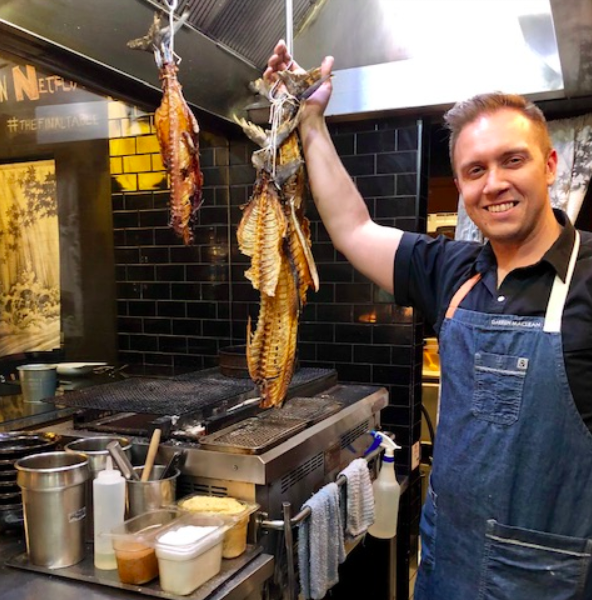This “The Final Table” Chef is Doing Something Amazing with Fish
If you’re looking for something to binge on during the holidays, watch a dozen teams of global top chefs work their culinary magic.
This “The Final Table” Chef is Doing Something Amazing with Fish
If you’re looking for something to binge on during the holidays, watch a dozen teams of global top chefs work their culinary magic.

Chefs try to impress the world's toughest palates on this culinary competition. Chef Darren MacLean is one of them.Netflix
I recently ducked into an unassuming worn-wood strip of a restaurant where I ate a table full of Japanese izaykaya such as quivering Hokkaido scallops sauced with yuzu, koshu and nuoc cham, matchless nigiri, and super-crunchy chicken skin chips topped with nitsume, scallions, mayo and bonito. I probably ate a dozen dishes or more, all of them complex, nuanced and fanciful. Chef Darren MacLean and his small brigade created these plates at Shokunin, in a tiny open kitchen in downtown Calgary.
After tasting his food, the first surprise was realizing the chef is a white guy from landlocked Alberta. The second surprise came when learning that this relatively unknown chef – even by Canadian standards – was invited to compete on Netflix’s “The Final Table”. And the third surprise (spoiler alert) was that he makes it to the finals.
After tasting his food I just had to sit down with Darren MacLean to find out if he’s got more surprises up his sleeve. It turns out, he does. A new restaurant on the way, and a fish-aging program.

“We age fish,” says MacLean. “We butcher them and keep them on the bone, heads off, guts out, and we scale them but leave the skins intact. Then we vacuum-seal them and keep them in the fridge in really cold ice water — we constantly change the ice so that it ages at almost one degree for four-to-five days. It breaks it down and gives it a wonderful texture.”
At his restaurant I discovered it’s especially great for nigiri. You know how sometimes you can have a bite of sushi and it almost snaps? Too rigid, with an off-putting chew. At Shokunin, they kill the fish by running a wire through the spines so the fish don’t go through rigor mortis. “With the aging it allows the fish to go through a bit of necessary decomp in order to bring out the sweetness of the flesh,” explains MacLean.
The chef traveled through Japan for eight months before opening Shokunin several years ago. He also visited Japan in his early twenties and every year thereafter four or five times a year to solidify his knowledge and to learn new techniques. He says that Google is also a hell of a thing.
“We’re also developing a dry-age fish program for larger hiramasa [Japanese yellowtail].” It’s a process by which you remove the scales and keep the skin intact. The skin ages in a static environment at about one degree. “You can’t have air circulating,” says MacLean. “You basically build a fridge within a fridge.” He says you hang the fish and the skin tightens up. The fish develops and begins to age, not unlike a piece of red meat. “In Japan I had a 14-day aged tuna belly,” he says. “It tasted like a medium rare steak.”
Follow us
This work is licensed under a Creative Commons Attribution-NoDerivatives 4.0 International License.
Want to republish a Modern Farmer story?
We are happy for Modern Farmer stories to be shared, and encourage you to republish our articles for your audience. When doing so, we ask that you follow these guidelines:
Please credit us and our writers
For the author byline, please use “Author Name, Modern Farmer.” At the top of our stories, if on the web, please include this text and link: “This story was originally published by Modern Farmer.”
Please make sure to include a link back to either our home page or the article URL.
At the bottom of the story, please include the following text:
“Modern Farmer is a nonprofit initiative dedicated to raising awareness and catalyzing action at the intersection of food, agriculture, and society. Read more at <link>Modern Farmer</link>.”
Use our widget
We’d like to be able to track our stories, so we ask that if you republish our content, you do so using our widget (located on the left hand side of the article). The HTML code has a built-in tracker that tells us the data and domain where the story was published, as well as view counts.
Check the image requirements
It’s your responsibility to confirm you're licensed to republish images in our articles. Some images, such as those from commercial providers, don't allow their images to be republished without permission or payment. Copyright terms are generally listed in the image caption and attribution. You are welcome to omit our images or substitute with your own. Charts and interactive graphics follow the same rules.
Don’t change too much. Or, ask us first.
Articles must be republished in their entirety. It’s okay to change references to time (“today” to “yesterday”) or location (“Iowa City, IA” to “here”). But please keep everything else the same.
If you feel strongly that a more material edit needs to be made, get in touch with us at [email protected]. We’re happy to discuss it with the original author, but we must have prior approval for changes before publication.
Special cases
Extracts. You may run the first few lines or paragraphs of the article and then say: “Read the full article at Modern Farmer” with a link back to the original article.
Quotes. You may quote authors provided you include a link back to the article URL.
Translations. These require writer approval. To inquire about translation of a Modern Farmer article, contact us at [email protected]
Signed consent / copyright release forms. These are not required, provided you are following these guidelines.
Print. Articles can be republished in print under these same rules, with the exception that you do not need to include the links.
Tag us
When sharing the story on social media, please tag us using the following: - Twitter (@ModFarm) - Facebook (@ModernFarmerMedia) - Instagram (@modfarm)
Use our content respectfully
Modern Farmer is a nonprofit and as such we share our content for free and in good faith in order to reach new audiences. Respectfully,
No selling ads against our stories. It’s okay to put our stories on pages with ads.
Don’t republish our material wholesale, or automatically; you need to select stories to be republished individually.
You have no rights to sell, license, syndicate, or otherwise represent yourself as the authorized owner of our material to any third parties. This means that you cannot actively publish or submit our work for syndication to third party platforms or apps like Apple News or Google News. We understand that publishers cannot fully control when certain third parties automatically summarize or crawl content from publishers’ own sites.
Keep in touch
We want to hear from you if you love Modern Farmer content, have a collaboration idea, or anything else to share. As a nonprofit outlet, we work in service of our community and are always open to comments, feedback, and ideas. Contact us at [email protected].by Amy Rosen, Modern Farmer
December 27, 2018
Modern Farmer Weekly
Solutions Hub
Innovations, ideas and inspiration. Actionable solutions for a resilient food system.
ExploreShare With Us
We want to hear from Modern Farmer readers who have thoughtful commentary, actionable solutions, or helpful ideas to share.
SubmitNecessary cookies are absolutely essential for the website to function properly. This category only includes cookies that ensures basic functionalities and security features of the website. These cookies do not store any personal information.
Any cookies that may not be particularly necessary for the website to function and are used specifically to collect user personal data via analytics, ads, other embedded contents are termed as non-necessary cookies.
Great article on the fish preservation. I work with coastal native Americans teaching traditional diet. Hope this will be of help to share fun new ways from old ways.